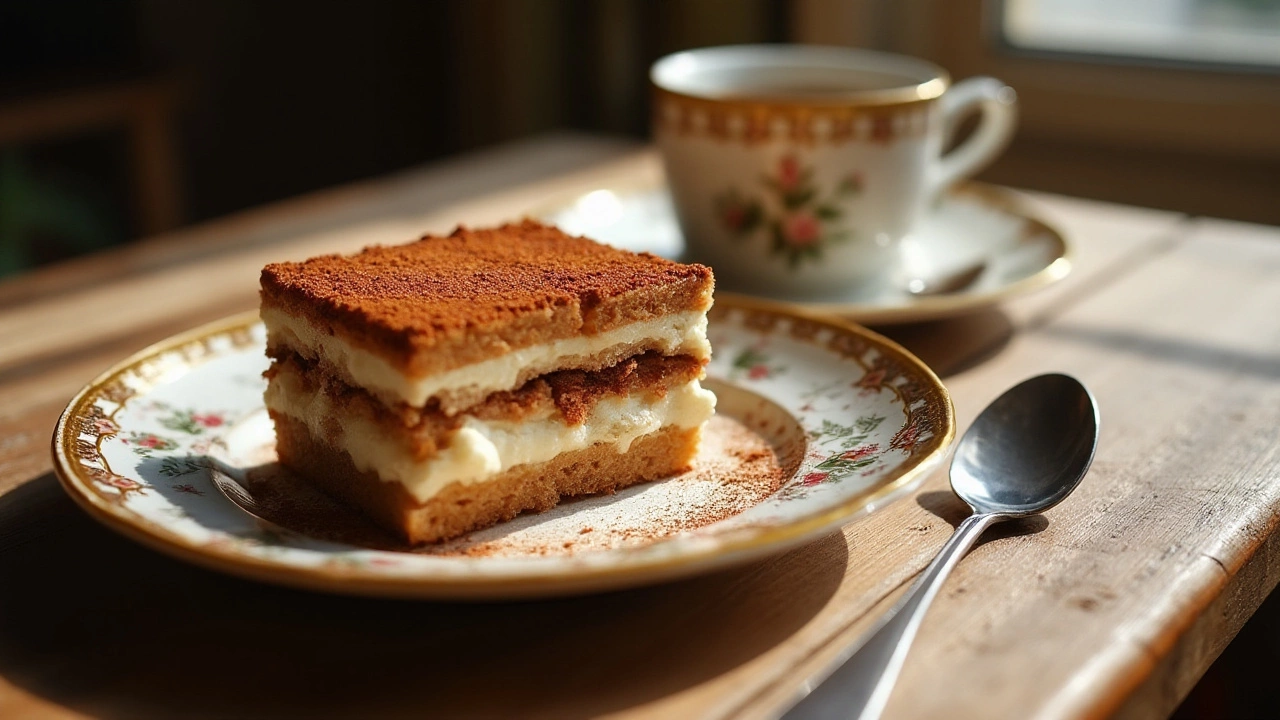Tiramisu, a dessert that holds a special place in the hearts of many, is often celebrated for its delightful layers and harmonious flavors. Originating from the Italian region of Veneto, this treat has traveled far beyond its native land to capture the taste of enthusiasts worldwide.
What makes tiramisu so captivating is its unique combination of ingredients that include coffee-soaked ladyfingers, a luscious mascarpone cream, and a dusting of cocoa powder. This blend creates a symphony of taste—bitter, sweet, and creamy, with each bite more memorable than the last.
The charm of tiramisu lies also in its simplicity, which allows for endless creativity and personalization. Whether you want to keep it traditional or experiment with new flavors, this dessert offers a canvas for both novice cooks and master chefs alike. So, let's dive into what makes tiramisu irresistible and why it might just be the best dessert in the world.
- The Origin of Tiramisu
- Ingredients that Make It Special
- How Tiramisu Became a Global Favorite
- Tips for Making the Perfect Tiramisu
- Unique Variations to Try
- Pairing Tiramisu with Drinks
The Origin of Tiramisu
Tiramisu's origins are as rich as its flavors. This beloved dessert first emerged in the heart of Italy, around the Veneto region, in the 1960s. Some claim it was born at Le Beccherie, a restaurant in Treviso, while others suggest it was first whipped up in a different kitchen altogether. What remains consistent, however, is the Italian roots that tie this indulgent treat to its culinary culture. At its core, tiramisu harmonizes the warmth of coffee with the creaminess of mascarpone, making it uniquely comforting.
Records hint that Tiramisu initially served as an energy booster. Traditionally, the word 'tiramisu' means 'pick me up' in Italian, a nod to its restorative qualities delivered through a combination of coffee and sugar. Such duality made it a perfect afternoon snack for weary Italians. Though its exact birthplace may be contested, its rise in popularity is undeniable. By the 1980s, tiramisu had crossed borders, becoming a darling of international dessert menus.
As its fame grew, so did the legends surrounding its creation. Some say it was crafted by a skilled pastry chef fed by nostalgia, while others lean towards a tale of romantic inspiration. Regardless of these stories' truths, the sentiment that tiramisu encompasses the warmth and hospitality of Italian culinary traditions rings loud and clear. In recent years, esteemed food historian Massimo Montanari pointed out, "Tiramisu's story is as layered as the dessert itself, reflecting a patchwork of cultural input and individual creativity."
"Like Italy itself, tiramisu reminds us of the power of blending simple ingredients to create something extraordinary." - Marcella Hazan, renowned Italian cookery writer.
Despite competition from other international desserts, tiramisu holds a special place in Italy, marking celebratory meals and family gatherings. As with many traditional dishes, its preparation is somewhat personal, with recipes and techniques passed down through generations, creating a deep-seated heritage rooted in daily life. As tiramisu continues to savor the palates of dessert enthusiasts, understanding its origin deepens our appreciation of this staple sweet and the vibrant cultural history that it represents.
Ingredients that Make It Special
When we talk about tiramisu, the importance of its ingredients cannot be overstated. The magic of tiramisu begins with the ladyfingers, known as savoiardi in Italy. These sponge-like cookies are pivotal in providing the necessary structure to the dessert. They are delicately soaked in espresso or strong coffee, absorbing just enough liquid to become soft but not so much that they lose their shape. This careful balance ensures that each bite delivers a rich coffee flavor complemented by the subtle sweetness of the ladyfingers themselves.
Another cornerstone of tiramisu is the velvety mascarpone cheese, a key player in the luscious cream filling. Mascarpone is a soft Italian cheese, renowned for its creamy texture and mild flavor. It’s gently folded into a mixture of beaten egg yolks and sugar, which together lend the dessert its signature smooth and rich profile. This amalgamation is not only indulgent but also perfectly harmonized with the other elements of tiramisu. To ensure the mixture remains light and airy, it is sometimes combined with whipped cream or beaten egg whites, adding volume and fluffiness.
Integral to the character of tiramisu is the slight bitterness achieved through the espresso. This is further accentuated by a generous dusting of unsweetened cocoa powder on top, providing contrast to the sweetness of the other components. A smidgen of rum or coffee liqueur often makes an appearance, either in the coffee soak or within the mascarpone layer, infusing additional depth and dimension to the flavor profile.
These ingredients come together to create a unique dance of flavors and textures that define tiramisu. A quintessential part of the dessert's allure is their ability to balance each other so perfectly, offering a culinary experience that is both delightful and memorable. This balance is key – too much mascarpone can make it overly rich, whereas insufficient coffee can leave it bland – making the proper assembly of tiramisu an art form in itself. As the legendary Italian chef Gino D'Acampo once said,“The secret to a good tiramisu is balance. It should have enough coffee to keep you going, but it should never overpower the dessert's delicate nature.”

How Tiramisu Became a Global Favorite
The spread of Tiramisu from its humble beginnings in Italy to a dessert adored across continents is a story worth unfolding. This dessert's journey begins in the north of Italy, amid the bustling cafes and sweet-smelling bakeries of Treviso, a city steeped in culinary tradition. Initially, Tiramisu was a well-kept secret, enjoyed primarily in local eateries. Yet, it didn't take long for its magic to cross regional borders. As Italians emigrated, they took a piece of home with them, including recipes passed down through generations. This sweet connectivity helped Tiramisu stage its real debut on the world's culinary stage.
The 1980s saw a remarkable turning point for Tiramisu, thanks to the rise of Italian cuisine's popularity in America. Homesick Italian chefs opened restaurants, showcasing their country's best, Tiramisu among them. It quickly became a staple on menus, praised for its unique blend of coffee, sweet cream, and subtle notes of cocoa. The cultural curiosity of the time led food critics and magazines to feature Tiramisu extensively, driving public interest and intrigue. A New York Times feature celebrated Tiramisu's ethereal texture and flavors in 1985, dedicating space to its simplistic beauty. By then, it was evident that Tiramisu was more than a fleeting trend.
The Role of Media and Internet
The media played a crucial role in catapulting Tiramisu to international fame. Cooking shows praised its straightforward preparation and rich taste, enticing viewers to try their hand at making it. The simplicity of its ingredients made it accessible, while the promise of sophistication appealed to aspiring chefs everywhere. The internet's onset only heightened Tiramisu's fame as recipes and reviews flooded websites and forums. Online food communities shared variations and innovative takes on the classic dessert, adding to its allure and ensuring its inclusion worldwide in every baker's repertoire. In an era when globetrotting sweet lovers rated and blogged about dishes, Tiramisu earned a prestigious and permanent seat.Food historian Mary Taylor Simeti once remarked, "No one can resist a dessert that promises to 'pick me up,’ both in body and spirit."This sentiment encapsulates Tiramisu's appeal; it's a treat that transcends taste. Starbucks even latched onto this success by introducing Tiramisu-inspired drinks, blending the dessert’s hallmark flavors into beverages globally. Coupled with the health-conscious shift where dark chocolate and coffee received praise for their potential benefits, Tiramisu thrived.
Ultimately, Tiramisu's ascent to global acclaim boils down to its marriage of familiarity and innovation; it satisfies both traditionalists and those eager for a modern twist. It's a classic perfected, yet always ready to surprise. With its sweet promise of joy, Tiramisu continues enchanting a universal audience, unifying diverse palates in appreciation of this truly delightful dessert.
Tips for Making the Perfect Tiramisu
Making the perfect tiramisu is often considered an art, one that demands attention to detail and respect for traditional methods. True to its Italian roots, it begins with the right choice of ingredients. Seek out authentic savoiardi or Italian ladyfingers—they possess a light, sponge-like texture that absorbs coffee without becoming soggy. When selecting coffee, opt for a strong espresso, as it imparts a robust flavor essential for an authentic tiramisu. Brew it fresh and let it cool slightly, allowing the flavors to intensify as they soak into the ladyfingers.
The beating heart of tiramisu is its creamy layer, comprised chiefly of mascarpone cheese, eggs, and sugar. Fresh mascarpone is key due to its subtle sweetness and silky texture. Be meticulous as you separate eggs; the yolks lend richness, while the whites need to be whipped to soft peaks for an airy lift. Blend mascarpone, yolks, and sugar until smooth, folding in the egg whites gently to maintain a light consistency.
An essential step often overlooked is ensuring your dessert has ample time in the refrigerator. Plan for at least four hours, ideally overnight. This allows the flavors to meld and the texture to firm up, offering that characteristic velvety elegance when served. When layering, aim for precision: a layer of coffee-soaked ladyfingers, followed by the mascarpone cream, and repeat. A sprinkle of cocoa powder before serving provides that signature bitter note that balances the creaminess.
For those with a creative flair, exploring variations can add a personal touch. Consider infusing your mascarpone with a splash of Marsala wine or rum for added depth. If you favor fruity notes, intersperse raspberries or strawberries within the layers, their acidity brightening each bite. As culinary expert Lidia Bastianich once said,
"Cooking is all about people. Food is maybe the only universal thing that really has the power to bring everyone together."Such versatility in tiramisu means each bite can tell a story, your story.
Don't forget the presentation, which can transform your creation from a simple dessert to a show-stopping finale. Use a glass dish to showcase its layers, or cut it into squares for a tidy presentation. Dust with cocoa just before serving to maintain its dryness and enhance its aroma. A little care in these final touches can elevate not just the look but the entire dining experience.

Unique Variations to Try
If there is one dessert that invites experimentation while still celebrating its classic form, it is tiramisu. Traditionally crafted with a base of coffee-soaked ladyfingers layered with mascarpone cheese, this Italian delight is a blank canvas for culinary creativity. While the original recipe is undeniably a wonder, the exploration of new versions provides both home cooks and professional chefs an opportunity to play and innovate. One popular twist you'll find is the use of different liquors—like sweet Marsala being swapped out for the bold flavors of dark rum or Bailey's Irish Cream. The spirit you choose can impart a distinct aroma, making each bite a new experience for the taste buds. The incorporation of various types of coffee, whether a robust espresso or a milder brew, also allows personalization of flavor profiles. Some adventurous souls even venture into dessert wines, attributing a gentle, velvety finish that complements the creaminess well.
Another fascinating variation comes in by substituting ladyfingers with other delightful bases. Think about the vibrant flavors of a rich pistachio or almond macaron, providing a different texture and subtle nutty undertones. Imagine biting into layers of fluffy sponge cake or experimenting with gluten-free alternatives that cater to different dietary needs. The mascarpone itself can become a playground for flavors, with possibilities such as infusing the cheese with vanilla pods, orange zest, or even a hint of ground cinnamon to bring warmth to each mouthful. Dessert chefs often find inspiration from various corners of the globe, such as Eastern spices or tropical fruits, to excite the palate and refresh seasonal menus.
"Food is symbolic of love when words are inadequate," wrote Alan D. Wolfelt, illustrating how food ties into emotion and creativity. With tiramisu, it's this boundless creativity that conveys an artist's soul into every dish presented.
A particularly charming aspect of evolving this classic is the introduction of fruity notes. Consider the gentle tartness of raspberries, the zest of lemon curd, or even the earthy sweetness of mango puree, all swirling into the mascarpone, coloring it with a spectrum of fresh tastes while balancing the lusciousness of the cream. These fruit elements not only add vibrancy in flavor but also in presentation—love at first sight with the eyes before the first forkful is taken. Moreover, for those tempted by the allure of chocolate, incorporating white or dark chocolate shaving encases the dessert in another layer of decadence.
No discussion about reimagining tiramisu would be complete without considering its deconstruction. This is where creativity truly knows no bounds: serving it in individual glasses to ensure perfect structure and portion, exploring the theatrical with roll cakes, or even spinning it on its head into an ice cream sundae format, where elements like strong espresso are swirled into creamy scoops and sprinkled with crunch to recreate the beloved texture are all possible.
With unique variations, every choice you make in transforming this revered dessert promises a new adventure. Whether you adhere to subtle stretches or push the boundaries entirely, the world of tiramisu evolves delightfully with each innovative touch, constantly inviting everyone to the table with fresh and exciting flavors.
Pairing Tiramisu with Drinks
Pairing tiramisu with the right drink can elevate your dessert experience from delightful to downright exquisite. Given its rich yet subtle flavor profile, choosing the best drink to complement tiramisu requires a bit of consideration. The dessert's key elements—coffee, mascarpone, and cocoa—are universal flavors that harmonize well with numerous beverages, yet they can easily be overshadowed if the pairing isn't carefully thought out. For many, a classic choice is to enjoy tiramisu with a cup of espresso. The robust, deep notes of coffee further enhance the coffee flavor within the tiramisu, creating an intense, aromatic experience that coffee lovers cherish. Besides, sipping a hot cup of espresso cuts through the richness of tiramisu, cleansing the palate and balancing the sweetness with its slight bitterness.
Wine lovers often opt for dessert wines like Vin Santo from Italy, which presents a harmonious match to tiramisu. The nutty and honeyed notes of Vin Santo complement the creamy mascarpone layers while adding a touch of luxuriousness to the dining experience. Alternatively, a good Marsala wine, which is sometimes used in the preparation of tiramisu itself, can create a seamless flow from dessert to drink. Vermouth may also be a viable option; its complexity and aromatic flavors dance wonderfully with the dessert's texture and taste. For those seeking something more unconventional, a well-balanced liqueur like Baileys Irish Cream offers a creamy, flavorful backdrop that vibes beautifully with the mascarpone cream.
Exploring Non-Alcoholic Options
Not everyone prefers alcohol, and there are splendid non-alcoholic options that can pair brilliantly with tiramisu. Hot chocolate, for instance, provides a luscious, velvety drink that meshes well with tiramisu's cocoa topping and enhances the overall chocolatey experience. Similarly, a chai latte, with its blend of spices, adds an exotic twist that complements the dessert's coffee elements. A vanilla-scented rooibos tea is another excellent choice, providing a fragrant, calming backdrop that synergizes with the layered complexity of the dessert.
According to Desserts and Drinks Monthly: "The versatility of tiramisu allows it to be paired with a wide array of beverages, making it a perfect component for any culinary experience."
If you are looking for a light, refreshing contrast, serving tiramisu with a sparkling mineral water can cleanse the palate between bites. The effervescence of the water contrasts well with the creaminess of the dessert, making each subsequent bite as delightful as the first. Remember, the goal of pairing is to complement and highlight the flavors, creating a balanced and enjoyable experience. Thus, whether you are a connoisseur of fine wines or prefer the simplicity of a warm tea, there's always a perfect drink to enhance your tiramisu enjoyment.





